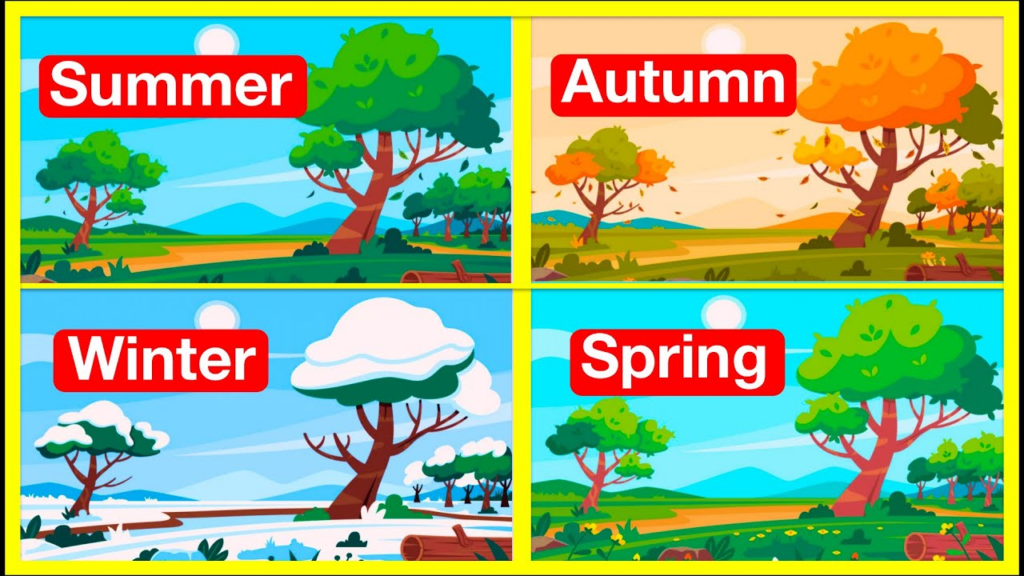Days of the Week, Months, and Seasons
HeyGen Introduction Video
Content
Days of the Week
The days of the week are the seven days that make up our week. They help us organize our time and plan things like school, homework, and fun activities. Each day has its own name, and we use them to talk about what happens every day!

Lunes = Monday – The first day of the week!
Example: “I go to school on Monday.”
Martes = Tuesday – The second day of the week.
Example: “I have soccer practice on Tuesday.”
Miércoles = Wednesday – The middle day of the week!
Example: “We have English class on Wednesday.”
Jueves = Thursday – The fourth day of the week.
Example: “My friends and I go to the park on Thursday.”
Viernes = Friday – The fifth day, and it’s almost the weekend!
Example: “We watch movies on Friday night.”
Sábado = Saturday – The first day of the weekend!
Example: “I love sleeping in on Saturday.”
Domingo = Sunday – The last day of the week.
Example: “We have a family lunch on Sunday.”
We usually divide the days of the week into weekdays and the weekend.
Weekdays: Monday, Tuesday, Wednesday, Thursday, and Friday. These are the days you go to school and work.
Weekend: Saturday and Sunday. These are your rest days!

One last thing! In Spanish, the names of the days are usually written in lowercase (minúscula), but in English, the names always start with a capital letter (mayúscula). ✅
Months
The months are the 12 parts that make up a year. We use the months to talk about time, holidays, birthdays, and seasons. Every month has its own name, and they help us plan and organize our year!

- Enero = January – The first month of the year!
- Example: “My birthday is in January.”
- Febrero = February – The month of Valentine’s Day!
- Example: “We celebrate Valentine’s Day in February.”
- Marzo = March – The beginning of spring in many places.
- Example: “We go on a school trip in March.”
- Abril = April – Known for April Fool’s Day (pranks and jokes!).
- Example: “In April, it rains a lot!”
- Mayo = May – Flowers bloom and the weather gets warmer!
- Example: “We celebrate Mother’s Day in May.”
- Junio = June – The start of summer for many countries!
- Example: “School ends in June.”
- Julio = July – The middle of summer with vacations!
- Example: “I go on holiday in July.”
- Agosto = August – Hot weather and summer vacations continue.
- Example: “We have summer camps in August.”
- Septiembre = September – The start of autumn in some places and a time to go back to school.
- Example: “School starts in September.”
- Octubre = October – Known for Halloween and autumn fun!
- Example: “We carve pumpkins in October for Halloween.”
- Noviembre = November – A month of thanks and cozy weather.
- Example: “November is great for Thanksgiving dinner.”
- Diciembre = December – The holiday season, Christmas, and New Year’s Eve!
- Example: “I love the Christmas decorations in December.”
Seasons
The months are also connected to seasons (spring, summer, autumn, and winter):

- Primavera = Spring: March, April, May
- Verano = Summer: June, July, August
- Otoño = Fall (US English) or Autumn (UK English): September, October, November
- Invierno = Winter: December, January, February
The following video is a summary of all the information in this lesson. It will also teach you how to pronounce the words you’ve learned for days, months, and seasons.
Practice Zone
Days of the Week
In this activity, you will complete a quick quiz about the days of the week.
For this next activity, match the days to their order in the week.
Click here to access the weekdays matching game
Months
In the following game, you must hit the moles with the names of the months.
For this activity, listen and match the month name with what you hear.
Click here to access the “Listen and Match” months activity.
Seasons
For this activity, drag and drop the activities into the right season.
Practice which months belong to each season with this next activity.
